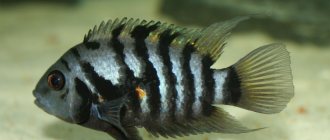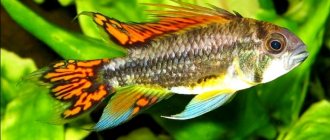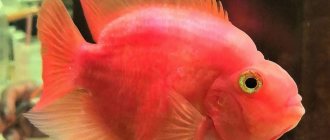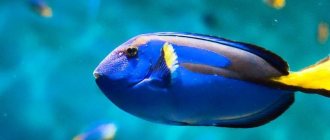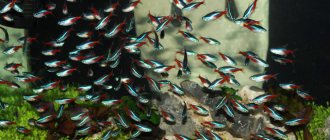Cichlids are a special aquarium world with their own orders. All cichlids have much in common: they require certain conditions of detention, do not tolerate many neighbors from other families, and almost always have a strict hierarchy. But within the family, these fish are so different that some species are easy to keep even for a beginner, while others may not be easy for even a very experienced aquarist to handle. Some species need a small aquarium of 30 liters, while others need at least 500 liters per individual.
Appearance of cichlids
Despite the fact that there are a huge number of species of these aquarium fish, you can easily distinguish them. Most cichlids look like this: they have an elongated body, well-developed slightly elongated dorsal and anal fins, a mouth with plump lips (and in large species, also with considerable teeth). The color is bright. They can be plain, variegated, have characteristic spots on the sides or stripes on the fins. They live in the middle and lower layers of water. Very active.
Of course, some cichlids don't fit this description entirely. But one way or another, each representative has several signs. Looking at an unfamiliar fish, you will most likely think: it is very similar to a cichlid. Most likely, this is it.
Cichlids vary in size: from tiny 2 cm long to giants up to 1 meter. But they are all territorial - having chosen a “home” for themselves (a cave, a thicket of grass, or just a corner they like), they protect it from the encroachments of their neighbors, even if they did not intend to encroach and were simply passing by. These character traits make cichlids the most interesting inhabitants of aquariums.
Maintenance and care
The general and main recommendation for caring for cichlids is to study the conditions in which the selected fish live in nature, and try to create them in the aquarium.
If these are residents of rocky areas, provide them with burrows, piles of stones, and ceramic tunnels. If future pets live in a soft environment, make sure there is driftwood that will soften the water. If you need flow, create it. Not necessary (for fish from small lakes) - don’t create it.
Aeration – some representatives require powerful aeration, while others can get by with minimal aeration.
Soil - some fish like to dig in the soil, then they need small stones. Others, digging around, create chaos in the aquarium; for such it is better to choose a larger faction.
Plants - for some cichlids this is a place of residence, refuge and maternity hospital, while others will happily eat all living plants within one week.
Water temperature – in general, cichlids prefer cool water of 22-26°C. Some representatives need warmer water. Sometimes temperature conditions (as well as hardness and acidity) are important for starting the reproduction process.
How to distinguish a male from a female and their reproduction in an aquarium
Male Cichlids usually have more pronounced colors and are slightly larger than females, but there are breeds in which the females are larger.
With the onset of maturity, males develop a fatty growth on the head in most species, which does not occur in females. Males often have a dark spot on their sides. Pisces are very constant, choosing one partner for themselves.
Various species of Cichlids reproduce well in an aquarium if the proper conditions are maintained. It is better to place the pair in a separate container for the spawning period, provide dim lighting and the desired temperature depending on the species, and do not disturb the fish at this time.
Of all aquatic inhabitants, these fish are the most caring parents. Cichlids dig a hole in the sand or choose a place on a stone, on leaves in a secluded place, lay eggs, fertilize them and protect them from other inhabitants of the aquarium. By moving their fins, the parents create water circulation over the clutch. They remove dead eggs and monitor the condition of the eggs. A litter can reach 2,000 eggs, but not all survive.
African breeds tend to hold the eggs in their mouths to ensure the safety of their offspring. These breeds can have up to 100 eggs. During the ripening period of eggs, they refuse food.
The newly hatched fry stay in a school just below their parents or one of the parents, so the fry feel safe.
Reproduction
In many cichlids, the females are different from the males. In some species, of course, the differences are not visible at all. They most often differ in color and size.
For the most part, these fish reproduce quite easily. First, a couple is formed, which is very interesting to watch. Cichlids choose a “nest” (a hole in stones, a corner with thickets of grass, a pitcher - depends on the species), protect it from neighbors, and the male cares for the female.
All cichlids are egg-laying. The female lays eggs and the male fertilizes them. But during evolution, two main types of bearing offspring have emerged. The first is traditional, when parents take turns guarding the eggs, fanning them with their fins. The second is primarily characteristic of the cichlids of Malawi and Tanganyika, where there are many enemies and few shelters. The parents hatch the eggs in their mouths. When the offspring hatch, the cichlid fry still hide in their parents’ mouths for some time at the slightest danger.
Other shapes and similar species
The ancestor of the snow prince, Pseudotropheus socolofi, deserves special attention. It is also known as Pseudotropheus pindani. Representatives of this species have uniform blue or light blue scales. However, sometimes you can notice transverse stripes, the shade of which is slightly different from the main one.
Dark, almost black stripes are often found on all fins of fish.
They are located closer to the edges of the fins and act as an edge. The head of Pseudotropheus pindani is large, with large eyes and a thickening in the frontal part.
Feeding
Since all cichlids are predators, it is impossible to do without food of animal origin. Even dry balanced mixtures contain protein components. Almost all cichlids love bloodworms. Many large species eat shrimp, pollock fillets, and some are fed small live fish (neons, guppies) once a week. This warms up interest in life and allows for some good hunting.
You need to add plant foods to animal foods to ensure a balanced diet. These include dry fish mixtures, pieces of cucumber, zucchini, and lettuce.
Classification
There are more than 1300 breeds of these fish! Of these, almost half feel good in home aquariums. They are united into several large groups according to their place of residence in nature: African (lakes Malawi and Tanganyika, rivers of Africa) and American (waters of Central and South America).
In addition to the diversity given by nature, breeders also succeeded in this matter and developed many breeds that are now very popular. Of course, the health of human-bred fish is weaker than the results of natural selection. But with proper care, fish have the same chance of a long and happy life.
Content Features
Cichlids are unpretentious and, with proper care, live 6-8 years. The following living conditions are important for the “snow prince”:
- large aquarium (at least 150 liters);
- water temperature - 24-27 degrees;
- hardness dH - 8-20;
- acidity pH - up to 8.6;
- regular filtration of liquid;
- weekly change of at least 50 liters of fresh water.
Powerful aeration is also important for snow-white fish. The bottom of the aquarium can be decorated with tall structures made of stones into which fish can swim. A mixture of gravel and shell rock is ideal as a soil. If possible, the aquarium is planted with plants with large, hard leaves.
Albino cichlids are suitable for live plant-based combination food. Some individuals love to feast on green salad leaves, while others will happily accept a piece of raw meat from their owner. Also, “snowflakes” will not refuse:
- pieces of raw pumpkin;
- nettle leaves;
- dandelions;
- frozen seafood.
These products must be boiled in boiling water for several minutes before use. Dry food containing spirulina (seaweed) is also suitable for white fish.
Hygrophila and Vallisneria bushes, which are planted in the aquarium, are suitable for feeding. Cichlids love plants like these.
African cichlids
There are river and lake varieties. River fish love soft and acidic water. Famous representatives:
- Nanochromis - has a gray-green body with transverse stripes. Females have a reddish belly
- Pelvicachromis pulcher, a parrot cichlid, is a small fish with a combination of dark brown, light ocher and black stripes running from the tail to the snout. The abdomen of males is reddish
- Lionhead cichlid, Steatocranus - has a gray body with pale yellow spots and a characteristic fatty growth on the forehead
Malawian cichlids
They live in a harsh and alkaline environment. They are divided into two groups - Utaka and Mbuna. Different representatives of each group can be kept in the same aquarium. Since all the fish have bright and varied colors, such aquariums are similar to sea aquariums.
Mbuna:
- Yellow cichlid, yellow cichlid, labidochromis, hummingbird cichlid is a yellow fish. Yellow cichlids look especially impressive if the back wall of the aquarium is a rich blue color
- Demasoni - cichlid with vertical dark blue and light blue stripes
- Melanochromis maingano, cichlid maingano - also dark blue and light blue stripes, but horizontal - from head to tail
- Yohani Cichlid - The males have a similar coloration to the Maingano, while the females are simply yellow-orange.
- The red zebra, zebra mbuna, is a cichlid that is bright orange fading to red.
- Pseudotropheus lombardo - in these cichlids the male is orange with pale vertical stripes in the dorsal fin area, and the female has black and blue stripes
- Melanochromis auratus, golden parrot, golden mbuna - a very aggressive fish, males are dark with yellow and blue stripes, and females, on the contrary, are yellow and have dark stripes
- Pseudotropheus pindani, pseudotropheus sokolov, blue pindani - blue cichlid with dark blue stripes on the fins
Utaka
Some species can be called peaceful cichlids, although they still remain predators:
- Haplochromis boazulu, protomelas boadzulu, cirtocara boadzulu, red empress cichlid, haplochromis red empress - the blue color of the head smoothly turns into an orange body with a dark stripe from the gills to the tail.
- Haplochromis kadango, Katanga cichlid, Opdichromis kodango - a fish with a blue head and a red body.
- Leopard cichlid, giraffe cichlid, Nimbochromis venustus - a fish with black spots on a yellow background and a blue head. Does not breed in captivity.
Description
Pelvicachromis is a member of the cichlid family . These fish, even in adulthood, do not exceed 10 cm in size, which allows them to be kept in a small aquarium.
The coloring of all varieties is variegated, bright and is often compared to the plumage of tropical birds.
Interesting! The name of the fish was first mentioned in 1901, and pelvicachromis began to gain popularity in 1913 thanks to German aquarists. In just a couple of years, the fish has spread throughout the world.
In addition to its beauty, aquarists value Pelvicachromis for its unpretentiousness. Fish do not require strict adherence to the quality of water and food .
Of course, extreme fluctuations in these parameters will affect the health of pets, but pelvicachromis easily forgives its owner for small errors in care.
Area
Throughout the globe, pelvicachromis are not very common in the natural environment.
They are mainly found in Africa (Nigeria, Cameroon). Relatively recently, populations of underwater parrots were also found in Ethiopia.
The fish live in fresh waters with slow currents, where the bottom is covered with dense thickets. Its unpretentiousness is confirmed by cases of detection of individual individuals in rivers with hard and salty water.
The diet of cichlids consists of invertebrate larvae, eggs of other fish and small plants from the bottom of reservoirs.
Appearance
An interesting feature of pelvicachromis and a difference from many other fish species is the equally bright coloring of representatives of both sexes .
Females are slightly smaller in size and have a more rounded belly.
Another common feature of all varieties of fish is longitudinal dark stripes on the sides. They are needed to capture water vibrations and orientation in space.
Unlike their parents, the fry are pale in color until they are several months old. Basically, all juveniles are gray in color with transparent fins and dark spots or stripes on the sides.
Behavior
Even among its cichlid relatives, Pelvikachromis stands out - it is friendly and gets along with all non-predatory fish of comparable sizes .
Aggression towards other species may occur during the breeding season, but this problem is easily solved by placing the pair in a spawning area.
Lifespan
Even in captivity, pelvicachromis live quite a long time - 7 or 8 years, if the rules of care are followed.
American cichlids
They prefer soft and acidic water.
Central American Cichlids
- Black-striped cichlazoma is considered one of the smallest representatives of its group, although in an aquarium it grows up to 13 cm. Color is alternating black and light blue stripes.
- Eight-banded cichlid, bee cichlid, Jack Dempsey is a multi-colored fish with eight (and sometimes more) dark stripes and many sparkle spots running along its body.
- Blue Dempsey is one of the subspecies of the bee cichlid, the most popular among aquarists, distinguished by the incredibly beautiful blue color of the sparkle spots on its body.
- Cichlazoma meeka, cichlid meeka - has a gray body with contrasting dark spots and a bright red belly and throat
South American cichlids
- Flamingo Cichlid - has a body shape that is more circular than typical cichlids. Color – soft pink
- The Eliot Cichlid is a very bright fish with color variations of grey, orange and blue with round dots all over the body and black spots along the sides.
- Cichlasoma salvini, Manga cichlid - has a yellow-orange body with black spots along the upper part of the body
- Apistogramma ramirezi, Apistogramma butterfly is a dwarf cichlid with bright colors. Reaches 4 cm in length. The nature of a predator, but due to its small size it is almost not dangerous and can be kept with peaceful fish
By the way, many species of South America belong to dwarf cichlids. In addition to a large group of apistograms, these are 6 types of nannakars, krenikaras, teniakaras, letakaras, etc. All of them are perfect for those who have a small aquarium, but have a great desire to watch cichlids.
Selection of neighbors for cichlids
It is believed that since cichlids are predatory fish with a developed desire to protect their territory, they cannot peacefully coexist with other species in the same aquarium. However, there is also an opposite opinion. Well-fed predators that do not lack food or personal space will not attack even defenseless fry.
For peaceful coexistence of fish, it is important to follow the following rules:
- You cannot place a flock in an aquarium of the wrong size. When selecting fish, you need to calculate the total volume of water in the container relative to the needs of each fish. When an aquarium is overpopulated, herbivorous species will be the first to suffer.
- Feeding fish should be timely and varied. You need to alternate different types of food daily. At the same time, you should not overfeed predatory fish and skimp on herbivores. Starving herbivorous fish will begin to eat algae and plants in the aquarium, which will lead to territorial wars.
- The desire to protect their territory among cichlids is ineradicable. But if you equip the aquarium, dividing it into zones and providing each couple with a spacious home, many fights and the death of fish can be avoided.
- Members of a mixed school have a greater chance of survival if they were introduced into the aquarium at the same time and at a relatively equal age of all fish. Cichlids that grow up in a constant environment of peaceful neighbors quickly get used to them and do not touch them, even as adults. But the new neighbor, who moved in much later, will most likely be quickly eaten.
- The young flock must be carefully monitored. If cichlids nevertheless begin to attack defenseless neighbors, then it is better to immediately resettle the herbivorous fish, without waiting for their death.
Don’t forget to follow 5 rules
If you ask an aquarist what fish cichlids get along with, he will list only three species:
- astronotuses;
- battles;
- blackheads
Cichlids do not get along well with small fish. In addition, they are annoyed by slow neighbors. These predators are considered to be completely incompatible with the following species:
- black telescopes;
- swordtails;
- iris;
- mollies;
- guppy;
- goldfish;
- catfish;
- rasboras;
- carp;
- cockerels;
- tetras;
- zebrafish;
- platies;
- gourami.
On the other hand, cichlids from different regions and different sizes always display their character in their own way. Small species are more peaceful. Asian cichlids are considered the most peaceful and calm. In the golden mean are African fish. “American” cichlids show the most aggression.
There are a number of fish with which they are not compatible
With American cichlids, you can keep fish that will be similar in size to them as adults. These are large handsome chromis and large melanotenias. Freshwater “Africans” of small size will become good neighbors of characoid species and synodontis.
Certain species of cichlids have their own behavioral habits in relation to neighbors of a different type:
- Cichlasoma Meeka and black-striped cichlasoma are not aggressive towards those fish with which they are kept in a common aquarium from juvenile age, provided that shelters are equipped for pairs.
- The eight-striped cichlazoma is more aggressive and only gets along with medium-sized neighbors.
- Cichlazoma severum calmly coexists next to any fish.
- Astronotuses raised in a community aquarium form their own cichlid flock and completely ignore all other types of fish, so even guppies are calmly housed with them.
- Apistogramma Ramirez (butterfly fish) does not attack even the smallest fish.
- Large parrots, reaching up to 8 cm in length, are peaceful towards almost everyone and always, but only until a stranger invades their territory. They usually show territorial instincts during spawning and before the fry grow up.
- Chromis beauties are aggressive, but may not touch the fish with which they grew up. They exhibit a very highly developed parental instinct. There is a known case when the owner resettled Chromis fry in order to protect them from attacks by other fish. The fry were placed in a separate container, which was placed in the “parent” aquarium in free swimming mode. A pair of chromis that gave birth to fry recognized them through the glass and began to drive other fish away from the container in order to save their offspring. This confirms the theory that fish are able to recognize their children by external signs without any auxiliary elements such as odors or signaling substances. At the same time, chromis always eat extraneous fry.
- Widespread angelfish almost never attack their neighbors.
- The Japanese parrot (Teraps) does not like small fish; it chases its medium-sized neighbors, but does not eat them.
- Melanochromis Johana ignores fish of other species; the formed pair separates from “their own” and tries to drive away fish of their own species.
- The Golden Parrot is safe for small and large fish and is forgiving towards the fry of other pairs.
- The Princess of Burundi is an insectivorous species that does not attack other fish and always stays in a school. This also applies to the spawning period. The young of all pairs are mixed and raised by the entire flock at the same time.
- The blue dolphin grows as long as the aquarium allows. The maximum recorded length is 25 cm. But even being so large, it coexists perfectly with small and medium-sized non-predatory neighbors.
- Pseudotropheus Lombarde is conditionally aggressive. Only males fight, and only with representatives of their own species. Females and other fish species are safe around them.
- The Queen of Tanganyika are huge (up to 35 cm) representatives of the cichlid family, which not only peacefully relate to other fish, but also often suffer from much smaller aggressors. They always try food for a long time and wonder whether it is worth eating. During this time, the more nimble neighbors manage to steal the food right from under their noses. The owner of the aquarium needs to feed the Tanganyika queen separately and make sure that no one attacks her.
This is an incomplete list of cichlids. Each aquarist can choose residents for his aquarium in accordance with his personal capabilities and preferences. It is worth remembering that some species are very rare and expensive. But the problem of combining different fish with the right approach is completely solvable.
In this video you will learn more about these fish:
Cichlid Compatibility
Cichlids rarely get along with other fish. Only the most peaceful ones. Representatives of their groups can live among themselves in a spacious aquarium (for example, only Tanganyika cichlids). It is less common to combine “Africa” and “America”. This is usually not possible due to different requirements for detention conditions. Be prepared for wars between and within species. Cichlids build a hierarchy, choose and protect shelters, and almost always have claims against all their neighbors - be it a sister cichlid or a pterygoplicht catfish. But this quarrelsomeness and restlessness is all the charm of the cichlid!
Cichlid diseases
These fish have good immunity, so they rarely get sick. They are susceptible to common fungal infections (ichthyophthyriosis, etc.), the manifestations of which are white spots and tubercles on the body, plaque, peeling scales, frayed fins. The fish become lethargic, hide, and healthy representatives (if there are any left, since usually the entire aquarium is infected) try to kill the sick fish. It can be treated with conventional means in accordance with the diagnosis. Typically these are drops that are added to the water with the lights off and minimal filtration.
Best neighbors
Most experts and owners of the snow prince agree that Pseudotropheus socolofi albino is best kept in a species aquarium, despite the relatively peaceful behavior of these cichlids. If you plan to be in the neighborhood with other species, you should pay attention to proportionate fish with a similar temperament that can fend for themselves.
Suitable neighbors for most pseudotropheus are:
It is not recommended to stock fish with veil fins near pseudotropheus; aggressive cichlids will gnaw them. Fish that are too quiet and slow will be forced to constantly hide. And very small neighbors can be perceived by the omnivorous snow prince as potential food.
